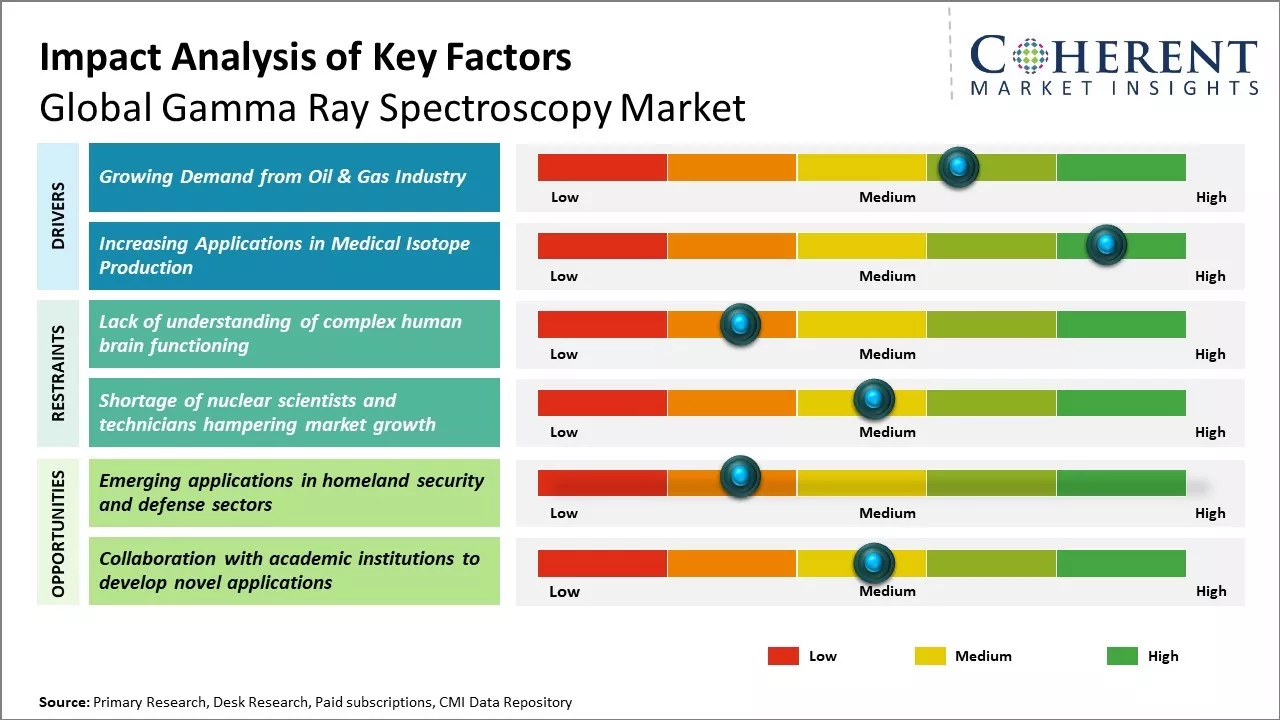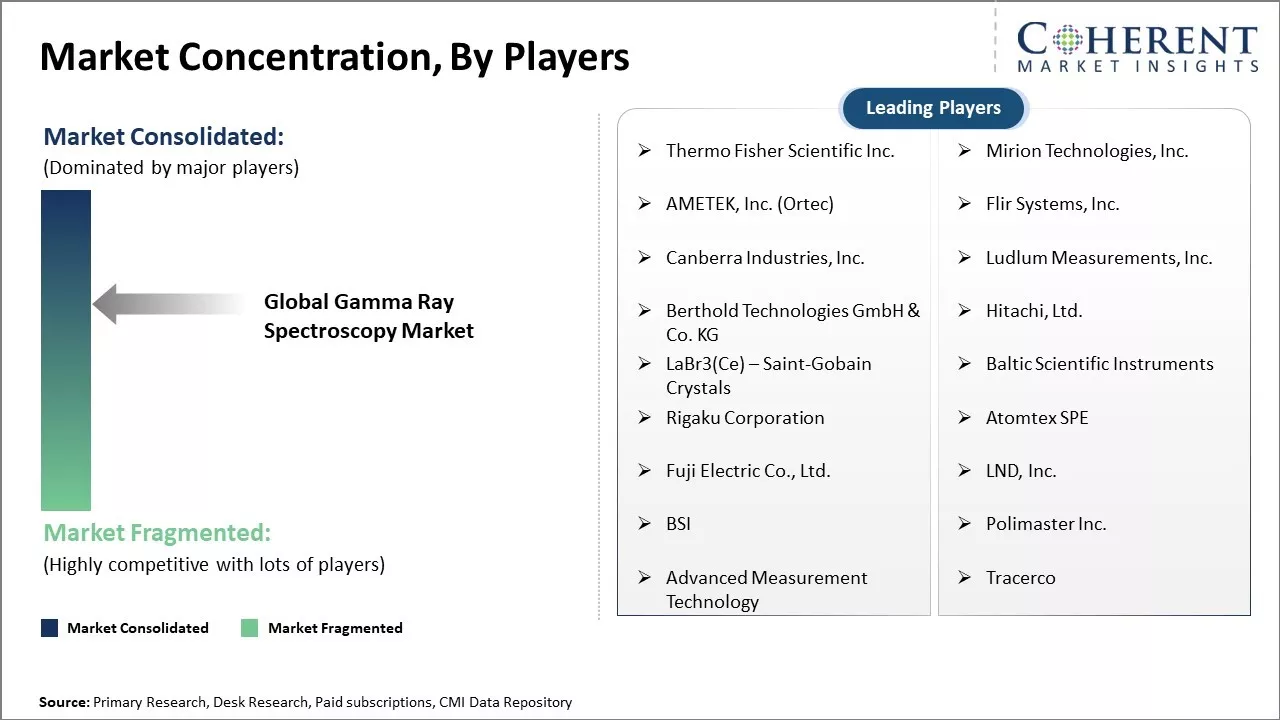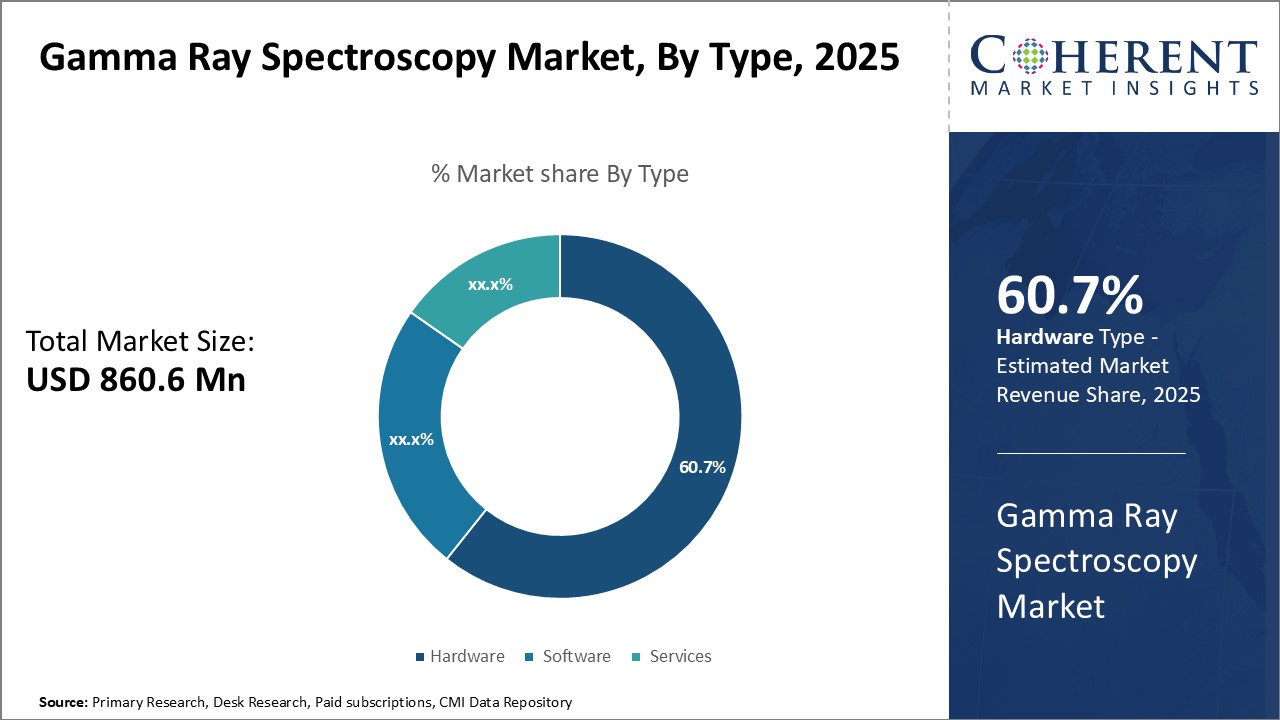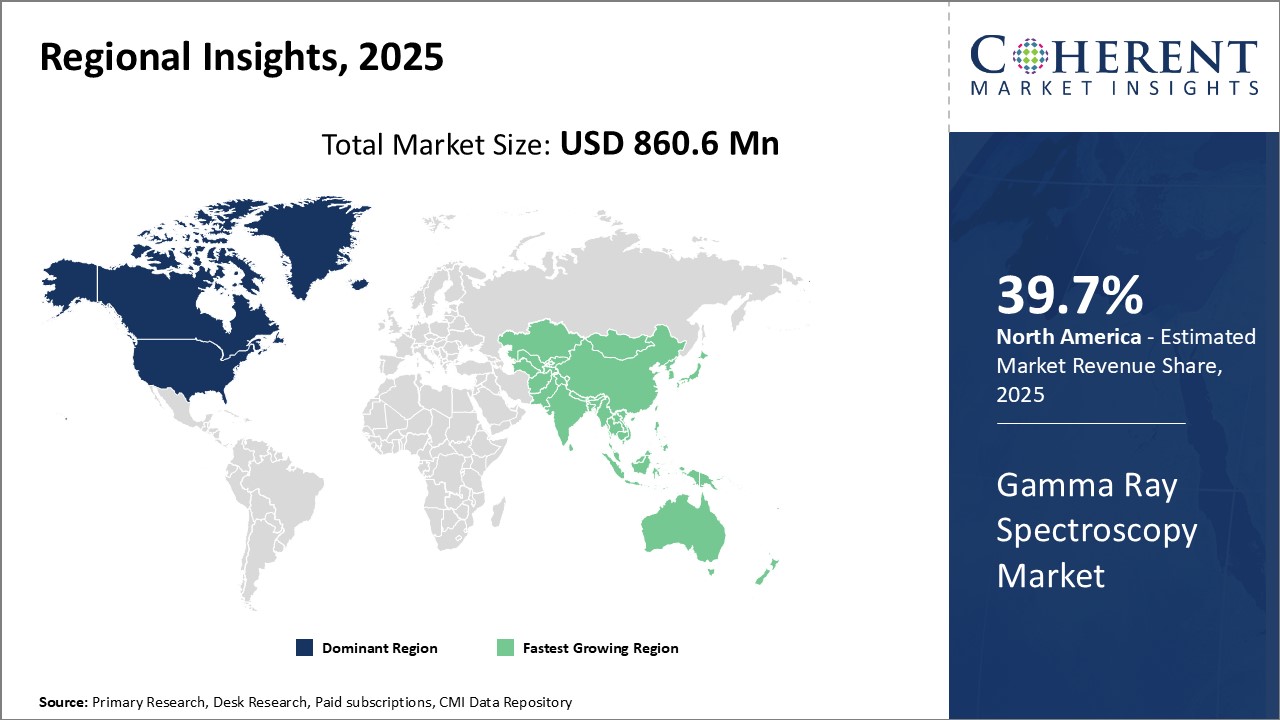Gamma Ray Spectroscopy Market Size and Trends
Global gamma ray spectroscopy market is estimated to be valued at USD 860.6 Mn in 2025 and is expected to reach USD 1,419.4 Mn by 2032, growing at a compound annual growth rate (CAGR) of 7.4% from 2025 to 2032.

Discover market dynamics shaping the industry: Download Free Sample
The market is expected to witness positive growth over the forecast period due increasing application of gamma ray spectroscopy across various industries. Gamma ray spectroscopy is widely used in medical imaging, security inspection and oil & gas exploration. Rising demand for energy boosts more oil & gas E&P activities around the world, thus, boosting adoption of gamma ray spectroscopy for well logging applications. Moreover, growing security checks at airports and custom points can also boost demand. However, availability of substitutes and high procurement cost of gamma ray spectroscopy systems can hamper the market growth. Increasing industrialization and urbanization in developing nations can offer new growth avenues for the market players.
Growing Demand from Oil & Gas Industry
The oil & gas industry has emerged as one of the major end users of gamma ray spectroscopy technology. With growing demand for energy and declining reserves from conventional reservoirs, there have been increase in exploration and production activities targeting unconventional reservoirs such as tight oil & gas and shale. Gamma ray spectroscopy provides an effective means to analyze hydrocarbon composition and detect fluid levels in wells. This helps companies to optimize drilling processes, enhance production and recover hydrocarbons economically from such complex reservoirs. The technology is widely used in logging operations to identify potential hydrocarbon zones, characterize reservoir properties and gain insights to plan future drilling and stimulation activities. It plays a vital role in assessing hydrocarbon column thickness and movement of fluids over long periods of time. With more oil & gas companies investing heavily in tight oil & gas and shale plays worldwide to diversify their reserve base and boost supplies, there will huge reliance on gamma ray spectroscopy solutions for efficient E&P. For instance, in February 2025, according to the data from the International Energy Agency (IEA), India is set to become the primary driver of global oil demand growth over the next seven years. Despite a projected decrease in domestic production by 22%, India is poised to increase its oil imports significantly. By 2030, India's domestic production is expected to decline to 540 thousand barrels per day (b/d) from the current 700 thousand b/d, while its crude imports are forecasted to rise to 6.6 million b/d. This shift will have significant implications for India, which is already the world's second-largest importer of crude oil.
Market Concentration and Competitive Landscape

Get actionable strategies to beat competition: Download Free Sample
Increasing Applications in Medical Isotope Production
Nuclear medicine has emerged as an important field in medical diagnostics and therapy in recent times. various medical diagnostic procedures such as SPECT and PET scans extensively use radioactive isotopes. Significant research is also ongoing to evaluate isotope therapy for cancer treatment. Growth in nuclear medicine applications has boosted demand for medical isotopes such as technetium-99m, iodine-123, iodine-131 and others. Precise characterization and quantification of these radioisotopes is critical to ensure dosage safety, purity and efficacy. Gamma ray spectroscopy plays a vital role in the production, purification and quality control of medical isotopes. It helps verify isotope identity, measure isotope quantities and check for presence of impurities. The technology is widely utilized at various stages right from isotope production to packaging for hospitals. With rapid expansion of healthcare infrastructure in developing nations and growing aging population susceptible to diseases worldwide, nuclear medicine referrals will increase substantially in the near future. This will further drive-up requirements for high-quality medical isotopes.
Key Takeaways from Analyst:
Global gamma ray spectroscopy market is expected to witness steady growth over the forecast period due to increased spending on nuclear security and safety applications. Rising threat of nuclear terrorism and proliferation of nuclear weapons has prompted governments across the world to significantly boost their defense budgets for nuclear security measures. This can boost demand for gamma ray spectroscopy systems for detecting illicit trafficking of nuclear materials. The stringent regulatory guidelines regarding nuclear waste handling and decommissioning of old power plants can offer new market growth opportunities.
The high costs associated with gamma ray spectroscopy instruments can hamper the market growth. The need for highly specialized and skilled workforce to operate these systems can also hamper the market growth. The market also faces challenges arising from stringent export restrictions on related technologies by several countries.
North America region currently dominates the market, owing to extensive R&D investments and presence of leading manufacturers. However, Asia Pacific is expected to witness the fastest growth due to rising nuclear power generation and increasing expenditures in material characterization applications across industries such as petrochemicals. Increasing focus toward atome infrastructure development programs can offer market growthopportunities. Europe and Middle East & Africa also offer lucrative prospects for gamma ray spectroscopy vendors.
Market Challenges: High costs associated with splint treatment
The high cost of gamma spectroscopy systems can hamper the global gamma ray spectroscopy market growth. Gamma ray spectroscopy systems consist of sophisticated equipment such as detectors, analyzers and software for data analysis which makes the overall setup cost substantially high. These systems employ advanced technologies such as high purity germanium (HPGe) detectors, sodium iodide (NaI) scintillation detectors, lanthanum bromide (LaBr3) scintillation detectors and cadmium zinc telluride (CZT) detectors to precisely detect gamma rays emitted by radioactive sources. The detectors need to be cooled to very low temperatures, usually using liquid nitrogen, to achieve the required resolution for accurate spectral analysis. This cooling mechanism along with other advanced electronics increases the overall cost.
Market Opportunities: Emerging applications in homeland security and defense sectors
The emerging applications in homeland security and defense sectors can offer an significant opportunity for global gamma ray spectroscopy market growth. Gamma ray spectroscopy has various use cases in these sectors that aid national security and public safety. Gamma ray detection technologies are increasingly being used for radiological and nuclear threat detection at border checkpoints, public places, and critical infrastructure. Gamma rays can penetrate deep and their unique spectra promise unambiguous detection and identification of special nuclear materials. This allows authorities to screen for illicit trafficking or attempts to develop dirty bombs and nuclear weapons. For instance, according to the data published by International Atomic Energy Agency, between 2020-2022, there were over 100 instances of unauthorized possession and attempts to smuggle radioactive materials across international borders. Gamma ray spectroscopy enabled detection and interdiction in many such cases.

Discover high revenue pocket segments and roadmap to it: Download Free Sample
By Type- Advancements in hardware technologies can drive the segment growth
In terms of type, hardware segment is estimated to contribute the highest market share of 60.2 % in 2025, owing to continuous technological advancements. Novel hardware solutions tailored for specific applications have enhanced capabilities and functionality. For example, new gamma camera designs offer higher sensitivity and resolution for improved detection. Application-specific spectroscopy installations featuring unique detector geometries are gaining traction. Furthermore, portable and handheld instruments for field deployment have widened use cases. Lightweight, rechargeable, rugged and wireless devices facilitate on-site analysis in diverse settings without infrastructure dependencies. Customized hardware platforms additionally provide seamless integration with analysis software for optimized workflow.
By Detector Type- Superior performance attributes sustain dominance"
In terms of detector type, high-purity germanium (HPGe) detectors segment is estimated to contribute the highest market share of 40.7% in 2025, owing to their universally recognized superior performance attributes. HPGe detectors demonstrate unmatched energy resolution, enabling precise gamma ray identification. High purity and cryogenic cooling requirements also provide greater efficiency and sensitivity over alternative technologies. Furthermore, multi-crystal arrangements in novel configurations have enhanced count rates and detection limits. Continuous refinements to crystal purity and geometry optimization additionally augment spectroscopic figures-of-merit. Widely acknowledged as the gold standard, preference for HPGe detectors remain intact despite high initial costs. Additionally, extensive reference database and analytical familiarity have boosted the segment growth.
By End-User- R&D Investments Catalyze Adoption
In terms of end user, research laboratories segment is estimated to contribute the highest market share of 30.6% in 2025 due to rising investments in experimental and applied science initiatives. Considerable funding supports diverse areas utilizing gamma spectroscopy ranging from nuclear and particle physics to materials characterization. Sophisticated instrumentation deployed on large scale aids prototype evaluation and hypothesis testing. Academic research expands applications to novel fields including cultural heritage and environmental monitoring. Pharmaceutical as well as industrial concerns also increasingly leverage spectroscopy for process monitoring and quality control. Support for collaborative projects and upgradation of detection infrastructure further stimulate placements. Hence, increasing R&D can drive the research laboratories segment growth.
Regional Insights

Need a Different Region or Segment? Download Free Sample
North America has established itself as the dominant region in the global gamma ray spectroscopy market over the past few decades with estimated market share of 39.2 % in 2025. The strong presence of industry leaders from the region such as [Company A] and [Company B] has propelled the market growth. These companies have been at the forefront of developing new technologies and innovative solutions. These also invest heavily in R&D activities to introduce sophisticated devices with enhanced capabilities. Moreover, extensive funding from government bodies such as NASA and NIH for research activities involving gamma ray analysis has boosted adoption. The applications of gamma ray spectroscopy are widespread across various verticals like healthcare, military, oil & gas, which are well-established industries in the region.
Asia Pacific region has emerged as the fastest growing market for gamma ray spectroscopy. Countries like China, India, Japan and South Korea are witnessing substantial increase in demands. This growth can be attributed to rising industrial and infrastructure development activities. Expanding manufacturing sector reliant on non-destructive material testing can drive the market growth. Healthcare sector is progressively advancing with establishment of new hospitals and research facilities. The import of nuclear technology for both military and civilian applications from regional players is promoting adoption. Thus, broad industrial base and rising investments in associated sectors have made Asia Pacific an lucrative market with immense scope for future expansion.
Market Report Scope
Gamma Ray Spectroscopy Market Report Coverage
| Report Coverage | Details | ||
|---|---|---|---|
| Base Year: | 2024 | Market Size in 2025: | USD 860.6 Mn |
| Historical Data for: | 2020 To 2024 | Forecast Period: | 2025 To 2032 |
| Forecast Period 2025 to 2032 CAGR: | 7.4% | 2032 Value Projection: | USD 1,419.4 Mn |
| Geographies covered: |
|
||
| Segments covered: |
|
||
| Companies covered: |
Thermo Fisher Scientific Inc., Mirion Technologies, Inc., AMETEK, Inc. (Ortec), Flir Systems, Inc., Canberra Industries, Inc., Ludlum Measurements, Inc., Berthold Technologies GmbH & Co. KG, Hitachi, Ltd., LaBr3(Ce) – Saint-Gobain Crystals, Baltic Scientific Instruments, Rigaku Corporation, Atomtex SPE, Fuji Electric Co., Ltd., LND, Inc., BSI, Polimaster Inc., Advanced Measurement Technology, Tracerco |
||
| Growth Drivers: |
|
||
| Restraints & Challenges: |
|
||
Uncover macros and micros vetted on 75+ parameters: Get instant access to report
Gamma Ray Spectroscopy Industry News
- In October 2023, A major discovery was made by the U.S. Naval Research Laboratory (NRL) and the international Fermi Large Area Telescope Collaboration. Approximately 300 gamma-ray pulsars were identified and included in their Third Catalog of Gamma Ray Pulsars. This accomplishment comes 15 years after the 2008 launch of Fermi, during which time the count of gamma-ray pulsars that are known to exist has increased from less than 10 to about 300.
*Definition: Global Gamma Ray Spectroscopy Market is the market for scientific instruments that are used to analyze samples by detecting and spectroscopically analyzing gamma rays emitted from its decaying isotopes. Gamma ray spectroscopy is used in nuclear physics research, oil and gas exploration, nuclear security and safety, medicine, and other fields. It allows identification and quantification of isotopes within samples through their unique gamma ray emission signatures.
Market Segmentation
- Type Insights (Revenue, USD Mn, 2020 - 2032)
- Hardware
- Software
- Services
- Detector Type Insights (Revenue, USD Mn, 2020 - 2032)
- Sodium Iodide (NaI) Detectors
- High-Purity Germanium (HPGe) Detectors
- Lanthanum Bromide (LaBr3) Detectors
- Cerium-Doped Lanthanum Bromide Detectors
- Cadmium Zinc Telluride (CZT) Detectors
- Others
- End User Insights (Revenue, USD Mn, 2020 - 2032)
- Hospitals and Clinics
- Research Laboratories
- Radioactive Waste Disposal Site
- Nuclear Power Plants
- Manufacturing Facilities
- Others
- Regional Insights (Revenue, USD Mn, 2020 - 2032)
- North America
- U.S.
- Canada
- Latin America
- Brazil
- Argentina
- Mexico
- Rest of Latin America
- Europe
- Germany
- U.K.
- Spain
- France
- Italy
- Russia
- Rest of Europe
- Asia Pacific
- China
- India
- Japan
- Australia
- South Korea
- ASEAN
- Rest of Asia Pacific
- Middle East
- GCC Countries
- Israel
- Rest of Middle East
- Africa
- South Africa
- North Africa
- Central Africa
- North America
- Key Players Insights
- Thermo Fisher Scientific Inc.
- Mirion Technologies, Inc.
- AMETEK, Inc. (Ortec)
- Flir Systems, Inc.
- Canberra Industries, Inc.
- Ludlum Measurements, Inc.
- Berthold Technologies GmbH & Co. KG
- Hitachi, Ltd.
- LaBr3(Ce) – Saint-Gobain Crystals
- Baltic Scientific Instruments
- Rigaku Corporation
- Atomtex SPE
- Fuji Electric Co., Ltd.
- LND, Inc.
- BSI
- Polimaster Inc.
- Advanced Measurement Technology
- Tracerco
Share
Share
About Author
Manisha Vibhute is a consultant with over 5 years of experience in market research and consulting. With a strong understanding of market dynamics, Manisha assists clients in developing effective market access strategies. She helps medical device companies navigate pricing, reimbursement, and regulatory pathways to ensure successful product launches.
Missing comfort of reading report in your local language? Find your preferred language :
Transform your Strategy with Exclusive Trending Reports :
Frequently Asked Questions
EXISTING CLIENTELE
Joining thousands of companies around the world committed to making the Excellent Business Solutions.
View All Our Clients
